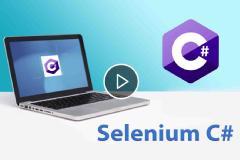Selenium WebDriver - Core Java
The "Selenium WebDriver Using Java" course is designed to provide participants with a comprehensive understanding of how to automate web applications using Selenium WebDriver with the Java programming language. This hands-on course will equip you with the skills needed to create robust and maintainable test automation scripts, effectively improve the testing process, and ensure the quality of web applications.
Course Highlights:
Duration: 5 weeks / 1.5 to 2 hours of per day (Flexible Timings)
Selenium WebDriver
Course Outline:
Module 1: Introduction to Selenium and Automation Testing
-
Importance of automation testing in modern software development
-
Overview of Selenium and its components
-
Setting up the development environment (Java, IDE, WebDriver, Maven)
Module 2: Getting Started with Selenium WebDriver and Java
-
Introduction to Selenium WebDriver
-
Installation and configuration of WebDriver and browser drivers
-
Creating a basic Java project for automation
Module 3: Locating Web Elements
-
Exploring different types of locators (ID, Name, XPath, CSS Selector)
-
Techniques for robust element identification
Module 4: Interacting with Web Elements
-
Performing actions such as clicking, typing, submitting forms
-
Handling dropdowns, radio buttons, checkboxes, and file uploads
-
Managing alerts, frames, and windows
Module 5: Synchronization and Waits
-
Understanding synchronization challenges in web automation
-
Implementing implicit and explicit waits
-
Handling AJAX calls and dynamic content loading
Module 6: Test Automation Frameworks with TestNG
-
Introduction to TestNG for test management and reporting
-
Organizing test suites and test cases
-
Parameterization and data-driven testing with TestNG
Module 7: Page Object Model (POM) Design Pattern
-
Introduction to the Page Object Model design pattern
-
Creating a POM-based automation framework
-
Benefits of using POM for test maintainability
Module 8: Advanced Interactions and Actions
-
Using Actions class for mouse and keyboard interactions
-
Handling drag-and-drop, context menus, and hover actions
Module 9: Data-Driven Testing
-
Parameterizing tests using TestNG's DataProvider
-
Reading test data from external sources (Excel, CSV, etc.)
Module 10: Cross-Browser and Parallel Testing
-
Configuring and executing tests on different browsers
-
Running tests in parallel for efficient test execution
Module 11: Real-World Projects and Case Studies
-
Building comprehensive automation scenarios for real web applications
-
Handling modern web application frameworks (React, Angular, etc.)
-
Performance testing using Selenium WebDriver
Module 12: Future Trends in Selenium WebDriver
-
Exploring emerging trends and new features in Selenium WebDriver
-
Introduction to web scraping using Selenium
Core Java
Course Outline:
Module 1: Introduction to Java
-
Overview of Java programming language
-
Setting up the development environment (JDK, IDE)
-
Writing and running the first Java program
Module 2: Variables and Data Types
-
Understanding variables and data types
-
Declaring and initializing variables
-
Type casting and conversion
Module 3: Operators and Expressions
-
Exploring arithmetic, relational, and logical operators
-
Using operators in expressions
-
Operator precedence and associativity
Module 4: Control Statements
-
Conditional statements: if, else if, else
-
Switch statements for multi-branch decisions
-
Looping: while, do-while, for loops
Module 5: Arrays
-
Introduction to arrays and array declaration
-
Accessing and manipulating array elements
-
Multidimensional arrays
Module 6: Methods and Functions
-
Defining and calling methods
-
Method parameters and return values
-
Method overloading
Module 7: Object-Oriented Programming (OOP)
-
Introduction to object-oriented concepts
-
Classes and objects
-
Constructors and instance variables
Module 8: Inheritance and Polymorphism
-
Implementing inheritance in Java
-
Method overriding and polymorphism
-
Abstract classes and interfaces
Module 9: Exception Handling
-
Understanding exceptions and error handling
-
Using try-catch blocks
-
Handling checked and unchecked exceptions
Module 10: Collections Framework
-
Introduction to collections and their benefits
-
Lists, Sets, and Maps
-
Iterating and manipulating collections







